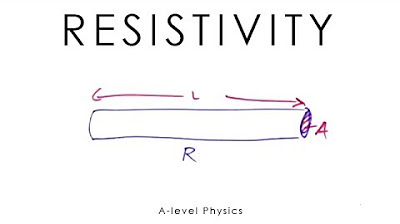Electrolytic conductivity | Circuits | Physics | Khan Academy
TLDRThis script explains the concept of measuring the resistivity and conductivity of liquids, akin to solids. It suggests using a known voltage and ammeter to calculate the resistance of a liquid with well-defined plates, and then applying Ohm's law to find resistivity. The script also highlights the use of a known resistivity solution for calibration, allowing for the measurement of unknown solutions' resistivity without repeatedly measuring area and length. It underscores the impact of impurities and dissolved salts on conductivity, offering insights into determining the concentration of conductive impurities.
Takeaways
- 🔌 Solids and liquids can both resist the flow of electric current, which is measured by their resistivity or conductivity.
- 🔋 When measuring resistivity, AC current is sometimes used to avoid electrolysis that could alter the liquid.
- 📏 The formula for resistivity involves resistance, area, and length, but the area measurement can be challenging in a liquid.
- 🛠️ To accurately measure liquid resistivity, a well-defined area is necessary, such as between two plates.
- 🔉 The distance between the plates (L) is a known factor in the resistivity formula.
- 🔌 Electrolytic solutions can conduct electricity, and the current flow can be measured with a battery and ammeter.
- ⚡ Ohm's law (V = IR) can be used to calculate resistance when voltage and current are known.
- 🧪 A known resistivity solution can be used as a calibration standard to measure the resistance of unknown solutions.
- 📈 Changes in measured electrolytic conductivity can indicate variations in the concentration of conductive impurities in a solution.
- 🔬 The resistivity or conductivity of a liquid can be experimentally determined using a setup with two plates and a known voltage source.
- 🔄 Impurities or dissolved salts in a solution affect its conductivity, which can be measured and used to determine concentration levels.
Q & A
What is the significance of measuring the resistivity of a liquid?
-Measuring the resistivity of a liquid is important for understanding its electrical conductivity, which can be used to determine the presence of impurities or dissolved salts, and is essential in various scientific and industrial applications.
Why might using DC current cause issues when measuring the resistivity of a liquid?
-Using DC current can lead to electrolysis, which produces bubbles that can alter the composition of the liquid, thus changing its resistivity and affecting the accuracy of the measurement.
What is the formula to calculate resistivity based on the given parameters?
-The formula to calculate resistivity (ρ) is ρ = R * A / L, where R is the measured resistance, A is the area of the plates, and L is the distance between the plates.
Why is it necessary to have a well-defined area when measuring resistivity?
-A well-defined area is necessary to ensure accurate measurements, as the resistivity formula involves the area of the conducting plates. Without a well-defined area, the resistivity calculation would be inaccurate.
What is the purpose of using two plates to measure the resistivity of a liquid?
-Using two plates provides a consistent and measurable area for the electrical current to pass through, allowing for a more accurate determination of resistivity.
How can you measure the resistance of a liquid using a known voltage and an ammeter?
-You can measure the resistance by applying a known voltage across the liquid and using an ammeter to measure the current. Then, using Ohm's law (V = I * R), you can calculate the resistance (R) as the voltage divided by the current.
What is electrolytic conductivity and how is it related to resistivity?
-Electrolytic conductivity is the reciprocal of resistivity. It measures how well a liquid conducts electricity and is directly related to the resistivity, with the formula: conductivity = 1 / resistivity.
Why might one use a solution with a known resistivity as a calibration step?
-Using a solution with a known resistivity allows you to calibrate your experimental setup and ensure that the measurements are consistent and accurate when testing other solutions.
How can changes in electrolytic conductivity indicate the presence of impurities or dissolved salts in a solution?
-Changes in electrolytic conductivity suggest variations in the solution's ability to conduct electricity, which can be caused by the presence of impurities or dissolved salts that affect the flow of current.
What is the advantage of using a calibrated electrolytic solution for measuring resistivity?
-Using a calibrated electrolytic solution with a known resistivity simplifies the measurement process, as you can determine the resistivity of an unknown solution by comparing its measured resistance to that of the known solution, without needing to measure the area and length each time.
How can the measurement of electrolytic conductivity help determine the concentration of conductive impurities in a solution?
-By comparing the measured electrolytic conductivity of a solution to that of a baseline solution, you can infer the concentration of conductive impurities, as their presence will alter the solution's ability to conduct electricity.
Outlines
🔌 Understanding Liquid Resistivity and Conductivity
This paragraph discusses the concept of resistivity and conductivity in both solids and liquids. It explains the process of measuring a liquid's resistivity by setting up a controlled experiment with two plates in the liquid, applying a known voltage, and measuring the resulting current with an ammeter. Ohm's law is used to calculate resistance, which, when combined with the area and length of the plates, allows for the determination of the liquid's resistivity. The paragraph also touches on the use of AC current to prevent electrolysis and the potential for measuring electrolytic conductivity or its inverse, which is a measure of how easily a liquid conducts electricity.
Mindmap
Keywords
💡Resistivity
💡Conductivity
💡Electrolysis
💡AC Current
💡Resistance
💡Ohm's Law
💡Ammeter
💡Electrolytic Solution
💡Calibrated Solution
💡Impurities
💡Concentration
Highlights
Solids and liquids both offer resistance to the flow of electric current, which is essential for defining resistivity and conductivity.
The resistivity of a liquid can be measured using a setup with a battery and electrodes, avoiding electrolysis by using AC current.
To determine resistivity, the formula involves resistance, area, and length, but measuring the area can be problematic.
A well-defined area is crucial for accurate resistivity measurement, suggesting the use of two plates submerged in the liquid.
The distance between the plates (L) and their area are key parameters for calculating resistivity using the formula.
Ohm's law is applied to find resistance by dividing the known voltage by the measured current.
An experimental method to measure liquid resistivity involves setting up a known voltage and measuring the resulting current.
Electrolytic resistivity or its reciprocal, electrolytic conductivity, can be determined through this experimental setup.
A known resistivity solution can be used as a calibration standard to simplify the measurement process.
By using a calibrated solution, the constant in the resistivity formula can be determined, streamlining further measurements.
Changes in electrolytic conductivity can indicate the presence of impurities or dissolved salts in a solution.
Measuring electrolytic conductivity can help determine the concentration of conductive impurities within a solution.
The method described provides a practical approach to understanding and measuring the electrical properties of liquids.
The importance of using AC current to prevent electrolysis and its impact on liquid composition is highlighted.
The relationship between resistivity, conductivity, and the physical dimensions of the experimental setup is emphasized.
The practical applications of measuring resistivity and conductivity in various industrial and scientific contexts are implied.
The transcript provides a comprehensive guide to experimental procedures for measuring liquid resistivity and conductivity.
Transcripts
Browse More Related Video

Resistivity - A-level Physics

Resistivity - Required Practical - A-level Physics

What is Conductivity | Chemistry | Alakh Pandey Sir | @AlakhSirHighlights

High School Physics - Resistance, Resistors, and Resistivity

Resistivity | Specific Resistance | Easier Explanation

What is Conductivity ? | Definition | S.I Unit | Formula | Faizan Zahid's Academy
5.0 / 5 (0 votes)
Thanks for rating: